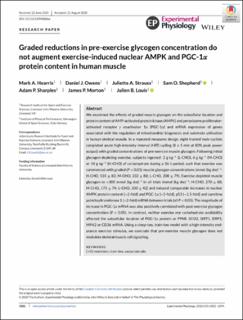Graded reductions in pre-exercise glycogen concentration do not augment exercise-induced nuclear AMPK and PGC-1α protein content in human muscle
| dc.contributor.author | Hearris, Mark A. | |
| dc.contributor.author | Owens, Daniel J. | |
| dc.contributor.author | Strauss, Juliette A. | |
| dc.contributor.author | Shepherd, Sam O. | |
| dc.contributor.author | Sharples, Adam | |
| dc.contributor.author | Morton, James P. | |
| dc.contributor.author | Louis, Julien | |
| dc.date.accessioned | 2021-02-01T10:48:06Z | |
| dc.date.available | 2021-02-01T10:48:06Z | |
| dc.date.created | 2020-10-14T12:01:39Z | |
| dc.date.issued | 2020 | |
| dc.identifier.citation | Experimental Physiology. 2020, 105(11), 1882-1894. | en_US |
| dc.identifier.issn | 0958-0670 | |
| dc.identifier.uri | https://hdl.handle.net/11250/2725534 | |
| dc.description | This is an open access article under the terms of the Creative Commons Attribution License, which permits use, distribution and reproduction in any medium, provided the original work is properly cited. | en_US |
| dc.description.abstract | We examined the effects of graded muscle glycogen on the subcellular location and protein content of AMP‐activated protein kinase (AMPK) and peroxisome proliferator‐activated receptor γ coactivator 1α (PGC‐1α) and mRNA expression of genes associated with the regulation of mitochondrial biogenesis and substrate utilisation in human skeletal muscle. In a repeated measures design, eight trained male cyclists completed acute high‐intensity interval (HIT) cycling (8 × 5 min at 80% peak power output) with graded concentrations of pre‐exercise muscle glycogen. Following initial glycogen‐depleting exercise, subjects ingested 2 g kg−1 (L‐CHO), 6 g kg−1 (M‐CHO) or 14 g kg−1 (H‐CHO) of carbohydrate during a 36 h period, such that exercise was commenced with graded (P < 0.05) muscle glycogen concentrations (mmol (kg dw)−1: H‐CHO, 531 ± 83; M‐CHO, 332 ± 88; L‐CHO, 208 ± 79). Exercise depleted muscle glycogen to <300 mmol (kg dw)−1 in all trials (mmol (kg dw)−1: H‐CHO, 270 ± 88; M‐CHO, 173 ± 74; L‐CHO, 100 ± 42) and induced comparable increases in nuclear AMPK protein content (∼2‐fold) and PGC‐1α (∼5‐fold), p53 (∼1.5‐fold) and carnitine palmitoyltransferase 1 (∼2‐fold) mRNA between trials (all P < 0.05). The magnitude of increase in PGC‐1α mRNA was also positively correlated with post‐exercise glycogen concentration (P < 0.05). In contrast, neither exercise nor carbohydrate availability affected the subcellular location of PGC‐1α protein or PPAR, SCO2, SIRT1, DRP1, MFN2 or CD36 mRNA. Using a sleep‐low, train‐low model with a high‐intensity endurance exercise stimulus, we conclude that pre‐exercise muscle glycogen does not modulate skeletal muscle cell signalling. | en_US |
| dc.language.iso | eng | en_US |
| dc.subject | CHO restriction | en_US |
| dc.subject | train-low | en_US |
| dc.subject | vastus lateralis | en_US |
| dc.title | Graded reductions in pre-exercise glycogen concentration do not augment exercise-induced nuclear AMPK and PGC-1α protein content in human muscle | en_US |
| dc.type | Peer reviewed | en_US |
| dc.type | Journal article | en_US |
| dc.description.version | publishedVersion | en_US |
| dc.rights.holder | © 2020 The Authors. | en_US |
| dc.source.pagenumber | 13 | en_US |
| dc.source.journal | Experimental Physiology | en_US |
| dc.identifier.doi | 10.1113/EP088866 | |
| dc.identifier.cristin | 1839487 | |
| dc.description.localcode | Institutt for fysisk prestasjonsevne / Department of Physical Performance | en_US |
| cristin.ispublished | true | |
| cristin.fulltext | original | |
| cristin.qualitycode | 1 |
Tilhørende fil(er)
Denne innførselen finnes i følgende samling(er)
-
Artikler / Articles [2119]
-
Publikasjoner fra Cristin [1107]
